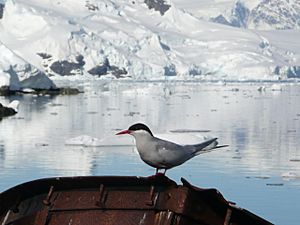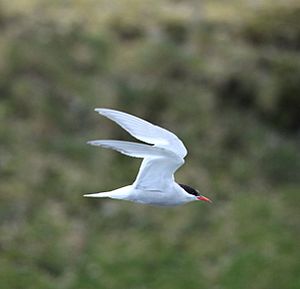Antarctic tern facts for kids
Quick facts for kids Antarctic tern |
|
|---|---|
 |
|
| Conservation status | |
| Scientific classification | |
| Genus: |
Sterna
|
| Species: |
vittata
|
The Antarctic tern (Sterna vittata) is a type of seabird. It belongs to the Laridae family, which also includes gulls. These birds live in the southern parts of the world's oceans. You can find them on small islands around Antarctica and along the mainland's coasts.
Antarctic terns mainly eat small fish and tiny crustaceans. They look a lot like their close relative, the Arctic tern. However, Antarctic terns are a bit chunkier. They also have their bright breeding feathers during the southern summer. This is when Arctic terns are losing their old feathers. Unlike Arctic terns, Antarctic terns do not travel long distances. But they still live across a very wide area. This tern species is actually more closely related to the South American tern.
Larger birds like Gulls, skuas, and jaegers often hunt the eggs and young of Antarctic terns. There are six different types, or subspecies, of the Antarctic tern. Around 140,000 of these birds live worldwide.
Contents
What Does the Antarctic Tern Look Like?
The Antarctic tern is a medium-sized bird. It is about 35 to 40 centimeters (14 to 16 inches) long. Its wings can spread out 74 to 79 centimeters (29 to 31 inches) wide. It usually weighs between 150 and 180 grams (5.3 to 6.3 ounces). They tend to be a bit heavier in winter.
Breeding Feathers
When breeding, the tern has light grey body and wings. Its tail is deeply forked, and its lower back and cheeks are white. It has a clear black cap on its head. This cap goes from the back of its neck down to its beak. Its eyes are brownish-black. The beak, legs, and feet are a bright red color.
Non-Breeding Feathers and Young Birds
When not breeding, the black cap is smaller. It only covers the area behind the eyes. The bird's belly and chest become lighter. Its beak turns a dull reddish-black. Young terns have yellowish-brown, grey, and white spots on their backs. Their belly and chest are yellowish-brown. Their beak is dull black, and their legs are dull red. Baby chicks are yellowish-brown with black spots on their heads and backs. Their belly is greyish-white, and their throat is darker. Their beak, legs, and feet can be flesh-colored or reddish-black.
How to Tell Them Apart
The Antarctic tern looks very similar to the Arctic tern. But Antarctic terns are in their breeding feathers when Arctic terns arrive. Arctic terns also have shorter legs. They have more noticeable black edges on their main wing feathers. The white-fronted tern also looks like the Antarctic tern. However, the white-fronted tern is bigger and lighter in color. It also has a longer black beak.
The different types of Antarctic terns (subspecies) vary a little in size and feather color. But it is often hard to tell them apart.
Antarctic Tern Family Tree
Terns belong to the Laridae family. This family also includes gulls and skimmers. Terns are part of a smaller group called Sterninae. The Antarctic terns are in the group called Sterna. There are six known types, or subspecies, of the Antarctic tern. Each subspecies breeds in specific places around Antarctica.
Different Types of Antarctic Terns
Here are the six recognized subspecies of the Antarctic tern:
- S. v. tristanensis – Found on Tristan da Cunha and Gough Island.
- S. v. sanctipauli – Found on St. Paul and Amsterdam Islands.
- S. v. georgiae – Found on South Georgia, South Orkney, and South Sandwich Islands.
- S. v. gaini – Found on the South Shetland Islands, Antarctic Peninsula, and nearby islands.
- S. v. vittata – Found on Prince Edward, Crozet, Kerguelen, Bouvet, and Heard Islands.
- S. v. bethunei – Found on Stewart, Snares, Auckland, Bounty, Antipodes, Campbell, and Macquarie Islands.
Where Do Antarctic Terns Live?
Antarctic terns like rocky places, especially small islands. These spots might have plants or not. They often live among other seabird species. They usually build their nests on cliffs. But they can also be found on rocky beaches. These places are usually safe from animals like cats or rats. They avoid beaches with sea lions, as sea lions take up all the flat areas. When it's not breeding season, these terns look for ice edges in Antarctica. They also visit beaches and rocky cliffs in South Africa.
This bird species lives in a very large area. It is found widely around the sub-Antarctic islands and the Antarctic mainland. Antarctic terns breed in Antarctica, Bouvet Island, the French Southern Territories, Saint Helena, Ascension and Tristan da Cunha, South Africa, South Georgia, and the South Sandwich Islands. Recently, some groups have started nesting on newly ice-free land on the north-eastern Antarctic Peninsula.
Each subspecies has its own specific breeding islands. After breeding, the Antarctic tern does not fly to the opposite side of the world like the Arctic tern. It usually stays close to its breeding islands all year. However, the terns from the southernmost areas do fly a bit further north for the rest of the year. They can be found in Uruguay, Argentina, Brazil, Chile, the Falkland Islands, Heard Island, the McDonald Islands, Australia, and New Zealand.
How Do Antarctic Terns Behave?
Their Calls
Antarctic terns are quite loud around their resting spots. Their main call sounds like “trr-trr-kriah.” They make this sound when flying or fishing. They also use a “chrrrr” sound to protect their nests from animals or people. They make a higher-pitched call to get their mate's attention.
What They Eat
The Antarctic tern eats whatever food it can find. It mostly eats small fish. It also eats some crustaceans, like Antarctic krill. They usually fish together in groups. They can form flocks of up to 100 birds when they find large groups of fish. They fish by hovering a few meters above the sea. When they spot prey, they have two ways to catch it. Most of the time, they will dive completely underwater. But if the water is too rough, they will only dip their beak while flying. They usually look for food near the shore in areas with kelp. They have also been seen in the areas between tides. Here, they scavenge for small crustaceans, worms, and shellfish. However, during the breeding season, they do not go far from their nest.
How They Reproduce
Antarctic terns usually breed from November to December. But this can change depending on the weather and how much food is available. The birds often live in small groups of 5 to 20 pairs. They can also nest alone. However, some islands have much larger groups, with over 1000 pairs. This tern species usually picks dips or hollows on cliff ledges for nesting. They can also nest on soil, sand, or grassy areas. They often make a small pit with pebbles or shells.
The female tern lays one or two eggs each breeding season. Both parents take turns sitting on the eggs for 23 to 25 days. The chicks hatch during the summer months, from December to February. Then, the parents feed the chicks for 27 to 32 days. This is how long it takes for the chicks to grow their flight feathers. Both parents continue to care for their young for several weeks after this. Antarctic terns that live past their first year can live for about 17 years. They can start breeding at 3 years old. This means they can have babies for about 10 years.
Gulls, skuas, and jaegers eat the eggs and chicks. Larger water birds also hunt the adult terns. This leaves young chicks open to bad weather and hunger. The Antarctic tern will protect its nest from any animals or people. They do this by repeatedly diving at them. Sometimes they even hit them with their sharp beak.
Dangers and Protection
The IUCN Red List says the Antarctic tern is a species of "least concern." This means it is not currently in danger. The number of these birds is stable. There are an estimated 132,000 to 145,000 individuals. About 45,000 pairs are breeding. Most of these are from the subspecies S. v. gaini.
However, sometimes terns on certain islands have trouble having babies. This is mostly because of animals like domestic cats and rats that have been brought to the islands.
See also
 In Spanish: Charrán antártico para niños
In Spanish: Charrán antártico para niños








